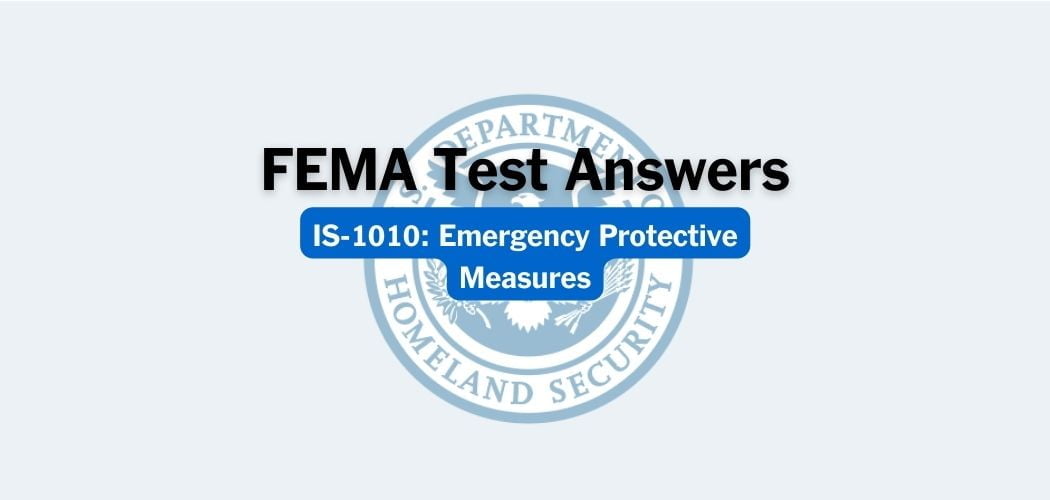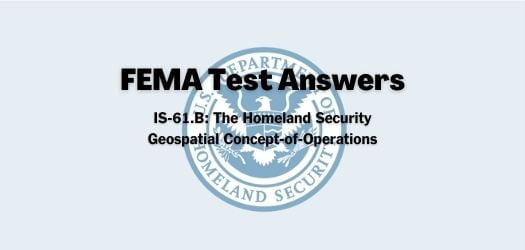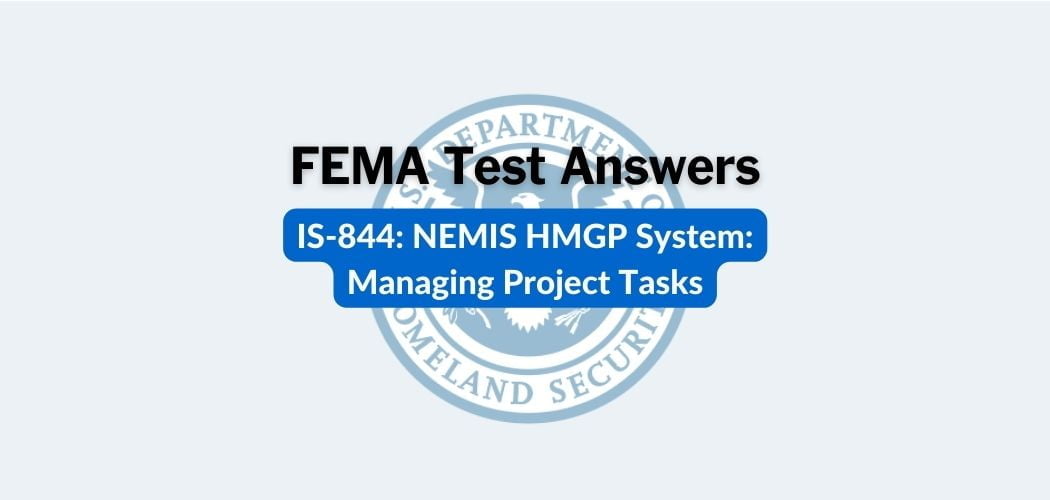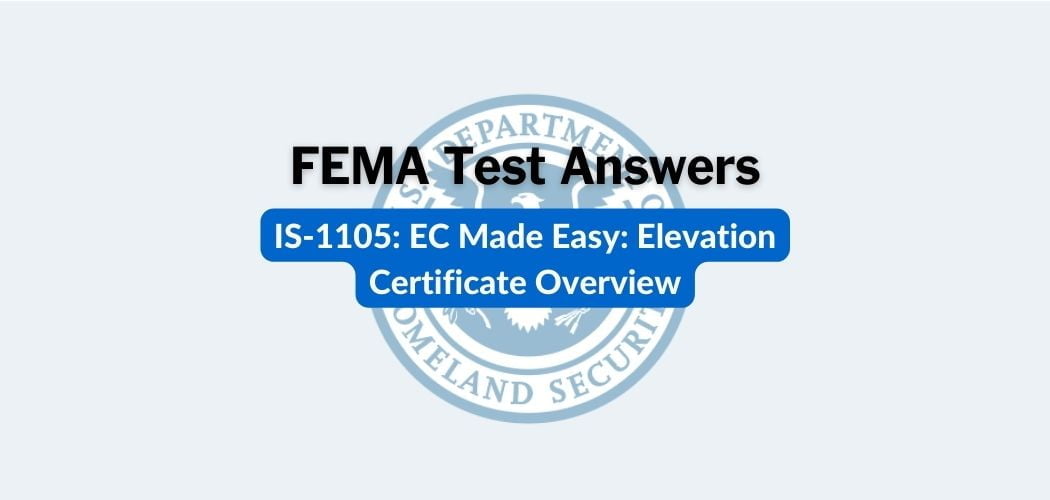Overview: The FEMA IS-322 course was published on 10/31/2013 to train Hazard Mitigation Advisor Specialists to explain both the flood hazard and how to mitigate future damages effectively, to people affected by floods.
NOTE: Each time the IS-322 final test is loaded, you will receive a unique set of questions and answers. The test questions are scrambled to protect the integrity of the exam.
FEMA IS-322 test answers
Question 1. When asked, FEMA staff should give specific repair directions to the public.
A. TRUE
B. FALSE✅
Question 2. When advising the public about flood mitigation, which action below should you take?
A. Google “rebuilding homes after a flood” and provide a list of websites.
B. Offer all of the NFIP publications to anyone and everyone.
C. Explain mitigation techniques from your own experiences.
D. Refer to appropriate FEMA-approved publications and websites, and recommend speaking with local building officials.
E. All of the above.✅
Question 3. River/stream flooding occurs when:
A. Water is trapped in an area because the outlet is too small or doesn’t exist. It accumulates over long periods and is slow to recede.
B. Intense rainfall creates a wall of water carrying rocks, mud, and debris, sweeping away objects in its path
C. Bodies of water rise due to heavy rain, melting snow, storm surge, or a dam breaking.✅
D. An off-shore storm pushes water inland to create higher-than-normal tides and a storm surge.
Question 4. Which statement below is correct about NFIP?
A. NFIP flood insurance is a mitigation measure that protects policyholders from the financial risk of flooding.
B. NFIP is available to all communities.
C. NFIP communities must have ordinances in place regarding all rebuilding.
D. All of these are correct.✅
Question 5. Which of the measures below may reduce the risk of future flood damages to a building?
A. Floodproofing
B. Flood control barriers
C. Structure elevation or relocation
D. Property acquisition
E. All of these may be appropriate mitigation measures✅
Question 6. Some communities may require the lowest floor of a structure in a Special Flood Hazard Area to be at BFE plus an additional freeboard elevation to account for:
A. Wave action
B. Bridge openings
C. Effects of urbanization on the watershed
D. All of the above✅
E. “a” and “b” only
Question 7. Why is it important to direct the public to local building officials?
A. Building officials will reinforce the importance of using licensed contractors.
B. They are knowledgeable about building codes, permits, zoning, etc.
C. There may be a floodplain ordinance in effect in the community.
D. The community may be participating in a mitigation grant program.
E. All of the above.✅
Question 8. Installing backflow valves on drainpipes or water lines is an example of dry floodproofing.
A. TRUE✅
B. FALSE
Question 9. Select the item that best describes coastal flooding.
A. Water is trapped in an area because the outlet is too small or doesn’t exist. It accumulates over long periods and is slow to recede.
B. Intense rainfall creates a wall of water carrying rocks, mud, and debris, sweeping away objects in its path
C. Bodies of water rise due to heavy rain, melting snow, storm surge, or a dam breaking.
D. An off-shore storm pushes water inland to create higher-than-normal tides and a storm surge.✅
Question 10. Which of the following is true about wet floodproofing?
A. Using waterproof veneer on any portion of a structure below the BFE is an effective wet floodproofing measure
B. One method of wet floodproofing involves elevating appliances and utilities to the BFE or higher.✅
C. Wet floodproofing can only be used for non-residential or commercial structures when they are Substantially Damaged or Substantially Improved.
D. All of these are correct.
E. None of these are correct.
Question 11. Which of the following is an example of dry floodproofing?
A. Waterproofing a structure below the BFE using a waterproof veneer.✅
B. Protecting appliances and utilities from flooding by raising them to BFE or higher.
C. Anchoring fuel tanks with straps and ground anchors.
D. All of these are examples of dry floodproofing
E. None of these are examples of dry floodproofing
Question 12. Mold cannot cause structural damage.
A. TRUE
B. FALSE✅
Question 13. Which is correct regarding a community that participates in NFIP?
A. An adopted floodplain ordinance regulates development in Special Flood Hazard Areas.
B. Flood insurance is available to property owners, businesses, and renters.
C. The floodplain ordinance must require substantially damaged or substantially improved structures in the floodplain to be brought into compliance with the current ordinance.
D. All of these are correct.✅
E. None of these are correct.
Question 14. An NFIP community is required to have:
A. A repair and rebuilding ordinance for areas, even those not in a flood zone.
B. An adopted floodplain management ordinance.✅
C. A definition of substantial damage that applies to the unique circumstances of the community.
D. All of these are correct.
Question 15. After a disaster event, which agency is responsible for the message to the public about mold hazards and remediation?
A. FEMA
B. Environmental Protection Agency (EPA)
C. US Public Health Service
D. The State Health Department✅
Question 16. FEMA publications can be found at FEMA.gov and :
A. FLASH
B. HM Disaster Workforce Website✅
C. IBHS
D. NAHB
E. All of the above.
Question 17. Hazard Mitigation (HM) staff should only distribute mold publications provided by HM Community Education and Outreach.
A. TRUE✅
B. FALSE
Question 18. Which issues should be considered before using flood control barriers to keep water out of a structure?
A. Local drainage can be unintentionally affected.
B. Substantially Damaged/Improved residences cannot use this method to bring the structure into compliance with floodplain ordinances.
C. Periodic maintenance is required to maintain effectiveness
D. All of the above.✅
E. “a” and “c” only
Question 19. How does closed-basin flooding occur?
A. Water is trapped in an area because the outlet is too small or doesn’t exist. It accumulates over long periods and is slow to recede.✅
B. Intense rainfall creates a wall of water carrying rocks, mud, and debris, sweeping away objects in its path.
C. Bodies of water rise due to heavy rain, melting snow, storm surge, or a dam breaking.
D. An off-shore storm pushes water inland to create higher-than-normal tides and a storm surge.
Question 20. Which of the following is an example of flash flooding?
A. Water is trapped in an area because the outlet is too small or doesn’t exist. It accumulates over long periods and is slow to recede.
B. Intense rainfall creates a wall of water carrying rocks, mud, and debris, sweeping away objects in its path.✅
C. Bodies of water rise due to heavy rain, melting snow, storm surge, or a dam breaking.
D. An off-shore storm pushes water inland to create higher-than-normal tides and a storm surge.
Question 21. Which FEMA-partner organization(s) below offer information on mitigating damage from floods?
A. IBHS
B. FLASH
C. NAHB
D. All of the above.✅
Other Hazard Mitigation answers
This module is one in a series of Independent Study modules for the Hazard Mitigation disaster workforce, which addresses appropriate basic mitigation information for public consumption regarding earthquakes, floods, hurricanes, tornados, and wildfires.



